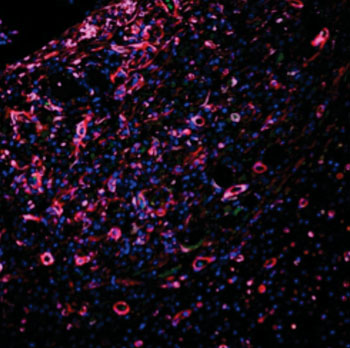Upgraded Hydrogel Stimulates Growth of New Blood Vessels for Tissue Regeneration
By LabMedica International staff writers
Posted on 04 Feb 2015
An upgraded hydrogel for in vivo use as scaffolding for cellular growth incorporates features that overcome most of the limitations that has precluded use of this type of material up to now.Posted on 04 Feb 2015
Major limitations of current tissue regeneration approaches using artificial scaffolds are (1) fibrous encapsulation, (2) lack of host cellular infiltration, (3) unwanted immune responses, (4) surface degradation preceding biointegration, and (5) artificial degradation byproducts. Specifically, for scaffolds larger than 200–500 micrometers, implants must be accompanied by generation of new blood vessels by the host (angiogenesis) in order to provide adequate nutrient/waste exchange in the newly forming tissue.

Image: The micrograph shows the extensive infiltration of robust blood vessels (red) in a new hydrogel scaffold developed to help the healing of internal injuries. The purple cells are pericyte-like cells that surround new endothelial cells, helping to stabilize the vessels. The green cells are circulating through the new vascular system (Photo courtesy of Dr. Vivek Kumar, Rice University).
Investigators at Rice University (Houston, TX, USA) reported in the January 13, 2015, online edition of the journal ACS Nano that they had designed a peptide-based self-assembling nano-fibrous hydrogel containing cell-mediated degradation and pro-angiogenic constituents that specifically addressed the limitations of earlier hydrogels. This hydrogel could be easily delivered by syringe, was rapidly infiltrated by cells of hematopoietic and mesenchymal origin, and rapidly formed an extremely robust mature vascular network. Scaffolds showed no signs of fibrous encapsulation and after three weeks were resorbed into the native tissue.
"Implanted synthetic materials tended to become encapsulated by fibrous barriers that kept cells and blood vessels from infiltrating the scaffold," said senior author Dr. Jeffrey Hartgerink, professor of chemistry at Rice University. "That is an extremely common problem in synthetic materials put into the body. Some avoid this problem but if the body does not like a material and is not able to destroy it, the solution is to wall it off. As soon as that happens, the flow of nutrients across that barrier decreases to almost nothing. So the fact that we have developed syringe-directed delivery of a material that does not develop fibrous encapsulation is really important."
"One thing that differentiates our work is the quality of the blood vessels that are formed," said Dr. Hartgerink. "In a lot of the published literature, you see rings that only have the endothelial cell lining, and that indicates a very immature blood vessel. These types of vessels usually do not persist, and disappear shortly after they show up. In ours, you see that same endothelial cell layer, but surrounding it is a smooth muscle cell layer that indicates a much more mature vessel that is likely to persist. There are a lot of features about this hydrogel that come together to make it a unique system. If you look through the literature at what other people have done, each concept that is involved in our system probably exists somewhere already. The difference is that we have all these features in one place working together."
Related Links:
Rice University













